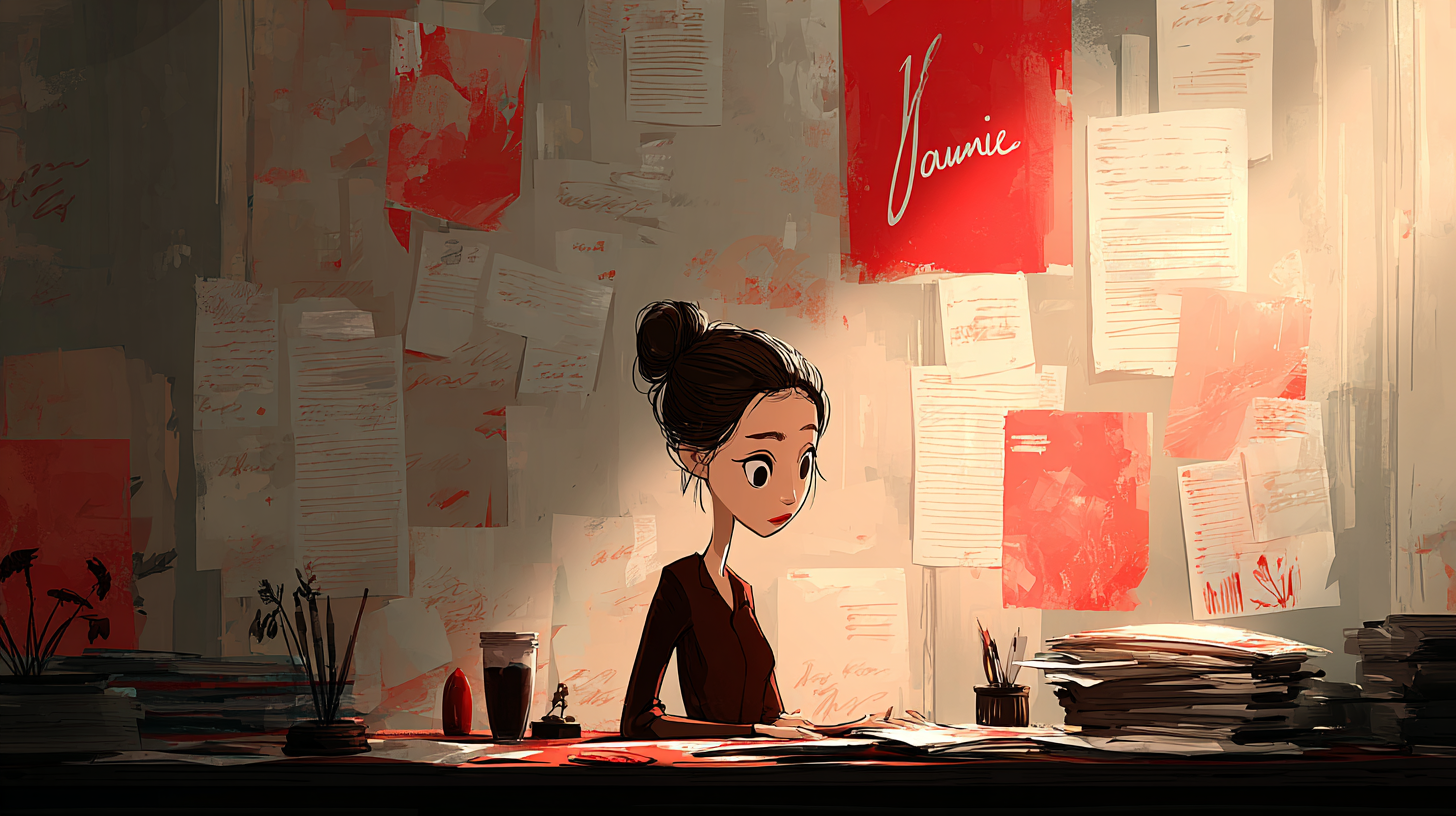“Feature” means “a special part of something” or “to show something in a special way.”
「feature」は「人や物の目立つ特徴」や「特集して紹介すること」を意味します。
以下は英単語 “feature” に関するストーリー型学習コンテンツです。まずは大枠の意味を理解して最後の文章で確認しましょう。
主な意味(main meaning)
| 品詞 | 発音記号 (IPA) | 意味 | 例文 |
|---|---|---|---|
| 名詞 (noun) | /ˈfiː.tʃər/ | 特徴、特色 | Honesty is an important feature of his character. |
| 動詞 (verb) | /ˈfiː.tʃər/ | 特集する、取り上げる | The magazine will feature young artists in the next issue. |
語源(etymology)
ラテン語 facies(顔、外見)に由来。
「顔に出る特徴」→「目立つ特徴」→「特集して取り上げる」というイメージ。
類義語(synonyms)
| 類義語 | 意味 | 例文 |
|---|---|---|
| characteristic | 特徴 | Kindness is a characteristic of good teachers. |
| trait | 特性 | Patience is an important trait for a nurse. |
| quality | 質、特色 | The phone has a new quality that makes it easier to use. |
| aspect | 側面 | One aspect of the job is dealing with customers. |
反義語(antonyms)
| 反義語 | 意味 | 例文 |
|---|---|---|
| commonness | 平凡さ | The commonness of the design made it less attractive. |
| ordinary | 普通 | His room looked ordinary without any special decoration. |
コロケーション(collocations)
| コロケーション | 例文 |
|---|---|
| special feature | The newspaper has a special feature on climate change. |
| main feature | The main feature of the new park is its large fountain. |
| unique feature | The unique feature of this phone is its foldable screen. |
| safety feature | The car includes a safety feature to prevent accidents. |
| feature film | We watched a feature film at the cinema last night. |
2項表現(binomials)
| 2項表現 | 例文 |
|---|---|
| features and benefits | The salesman explained the features and benefits of the new laptop. |
| facts and features | The guidebook lists the facts and features of the city. |
英語ストーリー(english story)
The New Project at the Office
Emma had been working at a publishing company for three years. One morning, her manager, Mr. Brown, called her into his office.
“Emma,” he said, “we are going to launch a new magazine next month. I want you to take part in it. The main feature (特徴) will be about young business leaders.”
Emma felt both excited and nervous. She had never been in charge of such a big project before. Still, she wanted to show her characteristic (特徴的な) hard work and creativity.
Her first task was to decide which leaders to interview. She looked for people with unique traits (特性), such as patience, honesty, and creativity. She knew that readers would be interested in these personal qualities (特色).
While preparing the articles, Emma worked closely with her colleague, David. David reminded her, “Don’t forget to check every aspect (側面) of the story, not only the business side but also their personal background.” Emma agreed. She realized that focusing only on numbers would make the article too ordinary (普通) and lose its charm.
To make the magazine more attractive, Emma suggested adding a special feature (特集) about “Safety Features (安全機能)” in new office buildings. This way, the magazine could appeal to a wider audience. Mr. Brown liked the idea and said, “This will be our unique feature (独自の特徴). It will show both features and benefits (特徴と利点) of modern workplaces.”
The team worked long hours. At times, Emma felt stressed, but she kept reminding herself that this was an opportunity to prove her ability. One evening, when the layout was almost done, David said, “Look, this page really shows the facts and features (事実と特徴) of the company.” Emma smiled.
Finally, the magazine was published. On the cover, the feature film (長編映画) actor who had started his own business was highlighted. Inside, readers could find stories about young leaders, office safety, and creative workspaces.
The feedback was amazing. Many readers said the magazine stood out because of its quality and unique features. One reader wrote, “What I love about this magazine is not only the information but also the way it combines features and benefits.”
Mr. Brown congratulated Emma. “Your hard work really paid off,” he said. “You showed that our magazine doesn’t have the commonness (平凡さ) of other publications. Instead, it has originality.”
Emma felt proud. She realized that the project was not only about publishing but also about discovering her own traits (特性) and qualities (特色). She had grown more confident and was ready for the next challenge.
和訳
職場での新しいプロジェクト
エマは出版社で3年間働いていた。ある朝、上司のブラウン氏が彼女をオフィスに呼んだ。
「エマ、来月新しい雑誌を出す予定だ。君にも参加してほしい。main feature(特徴) は若いビジネスリーダーについてだ。」
エマはわくわくすると同時に緊張した。大きなプロジェクトを任されるのは初めてだった。しかし、彼女は自分の characteristic(特徴的な) 努力と創造力を見せたいと思った。
最初の仕事は、どのリーダーを取材するか決めることだった。彼女は忍耐、誠実さ、創造力といった独自の traits(特性) を持つ人々を探した。読者はそうした人間的な qualities(特色) に興味を持つだろうと考えた。
記事を準備する間、エマは同僚のデイビッドと密に働いた。デイビッドはこう言った。「ストーリーのすべての aspect(側面) を確認するのを忘れないで。ビジネスだけでなく、個人の背景もだよ。」エマは同意した。数字だけに焦点を当てると記事があまりにも ordinary(普通) になり、魅力を失ってしまうと思った。
雑誌をもっと魅力的にするために、エマは「オフィスビルの safety features(安全機能)」についての special feature(特集) を提案した。これで雑誌は幅広い読者にアピールできるだろう。ブラウン氏はその考えを気に入り、「これが我々の unique feature(独自の特徴) になるだろう。現代の職場の features and benefits(特徴と利点) を示せるね」と言った。
チームは長時間働いた。エマはストレスを感じることもあったが、これは自分の力を証明するチャンスだと思い続けた。ある晩、レイアウトがほぼ完成したとき、デイビッドは言った。「見て、このページは会社の facts and features(事実と特徴) を本当に示しているよ。」エマは微笑んだ。
ついに雑誌は出版された。表紙では、自分の会社を始めた feature film(長編映画) 俳優が紹介されていた。中では、若いリーダーやオフィスの安全性、創造的な職場についての記事が読めた。
反応は素晴らしかった。多くの読者が、この雑誌はその quality(特色) と unique features(独自の特徴) で他と差別化されていると言った。ある読者は「この雑誌の良いところは、情報だけでなく、features and benefits(特徴と利点) を組み合わせている点です」と書いた。
ブラウン氏はエマを祝福した。「君の努力は本当に報われたね。他の雑誌の commonness(平凡さ) ではなく、オリジナリティがある。」
エマは誇らしく感じた。このプロジェクトは出版だけでなく、自分の traits(特性) と qualities(特色) を発見することでもあった。彼女はより自信をつけ、次の挑戦に備えていた。
Q&A
Q: “feature” と “characteristic” の違いは?
A: “feature” は外から見てわかる特徴や機能を指します。例えば「スマホの新しい機能」。
“characteristic” は、その人や物がもともと持っている性質で「典型的な特徴」という意味合いが強いです。例えば「教師に共通する特徴は忍耐」。
Q: “feature” と “trait” の違いは?
A: “trait” は性格や行動など、生まれ持ったり長く続く性質を指します。例えば「彼女の最も良い特性は優しさ」。
“feature” は外見や機能など、見える形で特定できる要素を指します。例えば「その建物の大きな特徴はガラスの壁」。
Q: “feature” と “quality” の違いは?
A: “feature” は「部分的な特徴」や「機能」を指し、具体的です。例えば「この車の安全機能」。
“quality” は「全体的な良さ」や「性質」を表し、抽象的です。例えば「彼女の優しさは素晴らしい性質」。
Q: “feature” と “aspect” の違いは?
A: “aspect” は「ある側面」「見方」を強調します。例えば「仕事の大変な側面」。
“feature” は「目立つ特徴」や「重要な要素」を示します。例えば「その都市の名所は主要な特徴」。
Q: “feature” と “commonness” の違いは?
A: “commonness” は「平凡さ」や「ありふれていること」を意味します。例えば「そのデザインは平凡だった」。
“feature” は「特別に目立つ部分」を意味するので、逆の概念です。
Q: “feature” と “ordinary” の違いは?
A: “ordinary” は「普通」「ありふれた」という意味で、特別感がないことを表します。
“feature” は逆に「際立つ点」や「注目すべき点」を表します。
Q: “special feature” と “unique feature” の違いは?
A: “special feature” は「特集記事」や「特別な紹介」という限定的な場面でよく使われます。
“unique feature” は「他にない独自の特徴」という意味で、唯一性を強調します。
Q: “safety feature” と “feature” の違いは?
A: “safety feature” は「安全を守るための具体的な機能」を指します。例えば「エアバッグは車の安全機能」。
単に “feature” というと「目立つ点」「特徴」で、安全に限らず広い意味になります。
Q: “features and benefits” の使い方は?
A: 商品やサービスの説明でよく使われ、「機能(features)」と「それで得られる利点(benefits)」をセットで示す表現です。
例えば「このスマホの特徴は長時間バッテリー(feature)で、その利点は充電の心配が少ないこと(benefit)」。
Q: “facts and features” の意味は?
A: “facts and features” はガイドブックや紹介文で使われ、「事実(facts)」と「特徴(features)」を合わせて簡潔に説明する時の表現です。
こうして整理すると、「feature」は「外から見える特徴・機能」に使うことが多く、他の類義語は「性質」「側面」「平凡さ」など、文脈によってニュアンスが異なることがわかります。



コメント